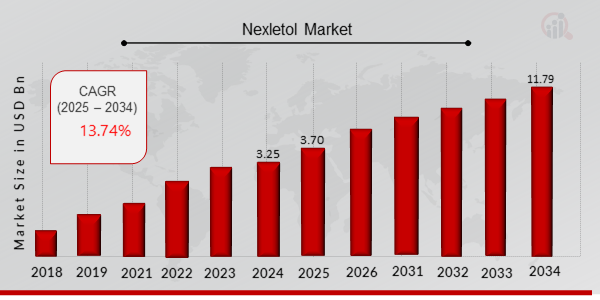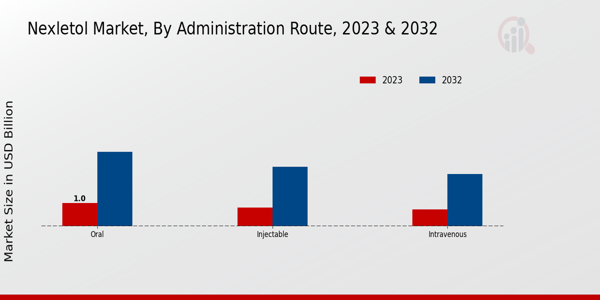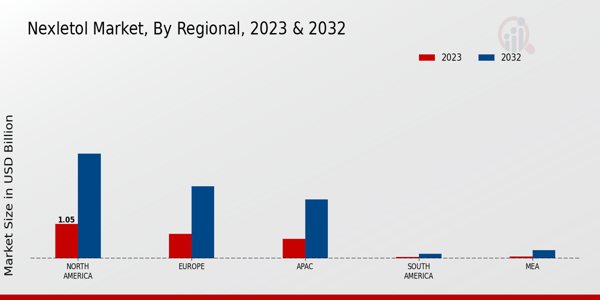Nexletol Market Overview
As per MRFR analysis, the Nexletol Market Size was estimated at 3.25 (USD Billion) in 2024. The Nexletol Market Industry is expected to grow from 3.70 (USD Billion) in 2025 to 11.79 (USD Billion) till 2034, at a CAGR (growth rate) is expected to be around 13.74% during the forecast period (2025 - 2034).
Key Nexletol Market Trends Highlighted
The Nexletol Market has been expanding owing to increasing cases of cardiovascular diseases and an endorsement for cholesterol management. As more people become aware of the health consequences of high cholesterol, the need for treatment rises. Preventive strategies are now more emphasized healthcare professionals, and for a number of patients, medicines such as Nexletol are considered as an important part of the therapy regimen. This trend is further driven by the aging population which is prone to cholesterol related issues more often than not. Furthermore, government campaigns that emphasize heart health and awareness increase the prospects of the market even further.
The Nexletol market has more opportunities to expand particularly within the developing regions where awareness concerning the heart is on the verge of progress. These markets can be opened by manufacturers establishing alliances with local health centers and offer training sessions. There is also room for R&D in developing combination therapies that would improve the therapeutic effect of Nexletol. In addition, telemedicine will be adopted increasingly by healthcare providers and make it possible to manage patients remotely, increasing the likelihood of compliance with medications. This change enables pharmaceutical companies to revise their marketing strategies and extend their reach to new target markets.
Recent trends indicate a move toward personalized medicine, where treatments are tailored to individual patient profiles. This shift allows for better management of cholesterol levels and can lead to improved patient outcomes. Increased collaboration between pharmaceutical companies and healthcare providers enhances the understanding of patient needs, enabling more effective communication of the benefits of Nexletol. Furthermore, digital health technologies are providing innovative ways to monitor patient progress, making it easier for both patients and doctors to stay engaged in the treatment process. As the focus on holistic health continues to rise, the market for Nexletol is positioned to adapt and evolve, catering to the growing demand for effective cholesterol management solutions.

Source: Primary Research, Secondary Research, MRFR Database and Analyst Review
Nexletol Market Drivers
Increasing Prevalence of Dyslipidemia
One of the most significant drivers for the Nexletol Market Industry is the rising incidence of dyslipidemia, characterized by abnormal levels of lipids in the blood, including cholesterol and triglycerides. As lifestyles change and risk factors such as poor diet, sedentary habits, and obesity become more prevalent, the demand for effective medications to manage cholesterol levels has surged. The Nexletol Market Industry is witnessing an upward trend as healthcare providers increasingly recognize the importance of maintaining optimal lipid profiles to prevent cardiovascular diseases.Increased awareness about the implications of high cholesterol and the detrimental effects of conditions associated with atherosclerosis and other heart-related issues have led healthcare professionals to recommend advanced therapeutic options like Nexletol. These therapies not only help to reduce low-density lipoprotein (LDL) cholesterol but also offer additional cardiovascular benefits. As public health initiatives focus on education regarding the risks of dyslipidemia, and as screening becomes more routine, the need for lipid-lowering medications will grow.Moreover, the introduction of new guidelines and the publication of clinical research supporting the efficacy of Nexletol in lowering cholesterol levels further drives its adoption in clinical practices worldwide. With the Nexletol Market expected to see significant growth driven by these factors, the increasing burden of dyslipidemia presents vast opportunities for pharmaceutical companies. This trend bodes well for the market as it aligns with health objectives aimed at reducing cardiovascular morbidity and mortality, thus ensuring a sustained demand for Nexletol and similar drugs in the forthcoming years.
Growing Focus on Preventive Healthcare
The Nexletol Market Industry benefits greatly from the rising emphasis on preventive healthcare measures. With a growing realization that it is far more effective and cost-efficient to prevent diseases rather than treat them, patients and healthcare providers alike are increasingly focused on maintaining health through proactive measures. As part of this shift, the management of cholesterol levels has come to the forefront, leading to a substantial rise in the uptake of Nexletol as a preventive intervention.Education about the health risks associated with high cholesterol levels has led to more people seeking medical advice and treatment before they experience serious health issues. This trend in preventive care is expected to fortify the Nexletol Market Industry as individuals prioritize health maintenance and seek out effective solutions for managing their lipid profiles.
Technological Advancements in Drug Development
The advancements in pharmaceutical technology and drug discovery processes have significantly impacted the Nexletol Market Industry. The development of innovative drug delivery systems and enhanced formulations has improved the efficacy and safety profiles of lipid-lowering medications, including Nexletol. Manufacturers are leveraging cutting-edge technologies to produce high-quality, targeted therapies that not only achieve better clinical outcomes but also enhance patient compliance.Furthermore, ongoing research is aimed at identifying new therapeutic targets and developing personalized medicine approaches that align with the unique genetic profiles of patients. Such advances not only contribute to market growth but also set the stage for future innovations in the Nexletol Market Industry.
Nexletol Market Segment Insights:
Nexletol Market Administration Route Insights
The Nexletol Market revenue in the Administration Route segment showcases a strong growth trajectory, with an overall market value estimated at 2.51 USD Billion as of 2023 and aiming to reach around 8.0 USD Billion by 2032. Within this Administration Route segment, the Oral administration method emerges as the dominant player, holding a significant share valued at 1.0 USD Billion in 2023, with growth expectations pushing its valuation to 3.2 USD Billion by 2032. The convenience and adherence aspects of oral administration strongly contribute to its majority holding in the market, as it offers patients an easier and more non-invasive way to manage their treatment regimens. In contrast, the Injectable method has also been noteworthy, initially valued at 0.8 USD Billion in 2023, expanding to an estimated 2.56 USD Billion by 2032. This route is particularly important in cases where rapid onset of action is necessary, and it plays a significant role in situations requiring precise dosing and administration oversight. Lastly, the Intravenous route, valued at 0.71 USD Billion in 2023, is expected to grow to 2.24 USD Billion by 2032. This delivery method is crucial in acute medical settings where fast and effective treatment is paramount, thus reinforcing its importance despite holding a smaller portion of the market compared to the Oral administration. The distinct characteristics and patient-centric benefits of these administration methods within the Nexletol Market data reveal different opportunities and applications that cater to diverse patient needs, highlighting the evolving dynamics and promising growth in the industry. The Nexletol Market segmentation clearly indicates the critical role of both oral and injectable methods in enhancing patient compliance and treatment outcomes. Furthermore, market trends show a steady demand for effective lipid-lowering therapies leading to increased interest in these administrational routes, yielding significant opportunities while navigating regulatory challenges to further expand market reach in the coming years.

Source: Primary Research, Secondary Research, MRFR Database and Analyst Review
Nexletol Market Indication Insights
The Nexletol Market, focusing on the Indication segment, is projected to hold significant value in the upcoming years, with an overall market expectation of 2.51 USD Billion in 2023. This segment is fundamentally crucial as it caters to a range of health conditions, primarily hyperlipidemia, atherosclerosis, and cardiovascular disease. Hyperlipidemia particularly plays a major role in driving demand, as it is a prevalent condition globally associated with increased cardiovascular risk. Atherosclerosis, characterized by the buildup of plaques in arteries, is another vital area of concern, affecting numerous individuals and contributing to severe health complications.Furthermore, cardiovascular disease remains a leading cause of morbidity and mortality worldwide, thus reinforcing the importance of Nexletol as a therapeutic option. The overall market growth indicates a robust demand for advancements within these indications, driven by rising awareness, innovations in treatment protocols, and a growing patient population. Market growth is facilitated by a keen focus on preventive care and the management of lipid levels, hence presenting ample opportunities for development in this sector.
Nexletol Market Distribution Channel Insights
The Nexletol Market, valued at 2.51 billion USD in 2023, showcases diverse Distribution Channels, significantly impacting reach and accessibility. Within this framework, Hospitals play a vital role, often being the first line of medication administration, thus commanding a prominent share in distribution. Retail Pharmacies provide essential services to patients seeking quick access to medication, contributing substantially to the market's dynamics. The rise of Online Pharmacies, driven by digitalization and consumer convenience, has emerged as a significant player, catering to a growing segment of tech-savvy consumers.The interplay among these channels is critical, as they complement each other while responding to patient needs and preferences. This distribution strategy supports the increasing demand for medications like Nexletol, reflecting broader trends in healthcare towards enhanced accessibility and patient-centric models. The Nexletol Market statistics further reveal how these channels are adapting to changing consumer behavior, which highlights both opportunities and challenges within the industry, and the ongoing growth in this sector is expected to drive market performance over the coming years.
Nexletol Market End User Insights
The Nexletol Market is poised for substantial growth, particularly within the End User segment, which encompasses Hospitals, Clinics, and Homecare Settings. In 2023, the market is valued at 2.51 billion USD, reflecting a rising demand across these critical environments. Hospitals play a significant role as they provide comprehensive healthcare facilities, making them a primary setting for Nexletol administration. Similarly, Clinics contribute significantly due to their accessibility and focus on outpatient care, catering to patients seeking preventative treatment.Homecare Settings are gaining traction, driven by the increasing preference for patient-centered health solutions and at-home monitoring. This trend is reshaping patient care paradigms, allowing for greater convenience and flexibility. The Nexletol Market data suggests a robust trajectory for the industry, supported by rising awareness of lipid management and cardiovascular health. Challenges include regulatory hurdles and the need for continued education among healthcare providers. However, the opportunities for growth remain abundant, particularly as demand rises for innovative therapeutic solutions in the market.With the market's expected expansion, the segmentation of End User reveals critical insights regarding healthcare delivery and patient care preferences.
Nexletol Market Regional Insights
The Regional segment of the Nexletol Market reveals considerable market growth across various areas, with the overall market expected to reach 2.51 USD Billion in 2023. North America represents a significant portion of this market with a valuation of 1.05 USD Billion, and is projected to grow to 3.2 USD Billion by 2032, showcasing its strong position and majority holding in the sector. Europe follows with a notable valuation of 0.75 USD Billion in 2023, that is expected to rise to 2.2 USD Billion by 2032, making it a key player in the Nexletol Market dynamics.The APAC region, valued at 0.6 USD Billion in 2023, also shows promising growth potential, reaching 1.8 USD Billion by 2032, which highlights an increasing demand for Nexletol treatments within this rapidly evolving market. South America and MEA, while smaller in comparison, valued at 0.05 and 0.06 USD Billion respectively in 2023, represent emerging markets where growth opportunities exist, albeit at slower rates, projected at 0.15 and 0.25 USD Billion by 2032. Such insights reflect the diverse landscape and segmented nature of the Nexletol Market, offering various opportunities for stakeholders through regional analysis and targeted market strategies.

Source: Primary Research, Secondary Research, MRFR Database and Analyst Review
Nexletol Market Key Players and Competitive Insights:
The Nexletol Market is characterized by a complex and evolving competitive landscape, driven by the demand for innovative therapies targeting cholesterol management. As healthcare systems increasingly prioritize treatments that effectively lower low-density lipoprotein cholesterol, companies engaged in this sector are compelled to leverage their unique capabilities and technological advancements to gain market share. This market is marked by a diverse range of players, including both established pharmaceutical giants and emerging biotech firms, all vying to provide effective solutions to physicians and patients. The competitive dynamics are further influenced by factors such as regulatory approvals, clinical trial outcomes, and the overall emphasis on personalized medicine, which collectively shape the strategies adopted by market participants.Pfizer stands out in the Nexletol Market due to its robust research and development capabilities and a well-established distribution network that enables widespread product availability. With a commitment to innovation and a strong pipeline of cholesterol-lowering therapies, Pfizer has solidified its position as a key player in the market. The company's extensive experience in cardiovascular disease management, along with its reputation for high-quality products, enhances its competitive edge in the realm of Nexletol. Pfizer’s strategic collaborations with healthcare providers and robust marketing initiatives further amplify its brand presence. The company's focus on patient-centric solutions and effective treatment regimens resonates well with healthcare professionals, contributing to strong demand for its offerings in the cholesterol management domain.Amgen also plays a significant role in the Nexletol Market, notably leveraging its expertise in biopharmaceuticals to advance treatment modalities for abnormal cholesterol levels. The company is recognized for its commitment to developing innovative therapies that address unmet medical needs in lipid management. Amgen’s robust clinical research programs validate the safety and efficacy of its products, fostering confidence among healthcare professionals and patients alike. Its strong emphasis on leveraging biotechnology allows Amgen to create novel treatment options that stand apart from traditional medicines. The company’s presence in the market is enhanced by strategic alliances and partnerships that facilitate access to various markets, ensuring that it remains a formidable competitor in the evolving landscape of cholesterol management therapies.
Key Companies in the Nexletol Market Include:
-
Pfizer
-
Amgen
-
Merck
-
Teva
-
Bristol Myers Squibb
-
Eli Lilly
-
AbbVie
-
GSK
-
Roche
-
Johnson and Johnson
-
Boehringer Ingelheim
-
AstraZeneca
-
Bayer
-
Novartis
-
Sanofi
Nexletol Market Industry Developments
Recent developments in the Nexletol Market have been notable, particularly with key players such as Pfizer, Amgen, Merck, Teva, Bristol Myers Squibb, Eli Lilly, AbbVie, GSK, Roche, Johnson & Johnson, Boehringer Ingelheim, AstraZeneca, Bayer, Novartis, and Sanofi actively engaged in shaping the competitive landscape. The market has witnessed significant growth attributed to the increasing awareness of cholesterol management and the rise in cardiovascular diseases. This has spurred companies to enhance their product offerings and invest in research and development. Recent news indicates that several firms are exploring innovative treatment options to improve patient outcomes, thus contributing to the overall market valuation. Merger and acquisition activity among these companies has also been prevalent, as they look to consolidate resources and expand their market presence. The push for strategic alliances and partnerships points to a broader trend focused on enhancing therapeutic capabilities. Companies are consistently evolving their market strategies in response to regulatory changes and competitive pressures, ensuring they remain agile and responsive to market needs while striving for improved economic performance and shareholder value.
Nexletol Market Segmentation Insights
-
Nexletol Market Administration Route Outlook
-
Oral
-
Injectable
-
Intravenous
-
Nexletol Market Indication Outlook
-
Hyperlipidemia
-
Atherosclerosis
-
Cardiovascular Disease
-
Nexletol Market Distribution Channel Outlook
-
Hospitals
-
Retail Pharmacies
-
Online Pharmacies
-
Nexletol Market End User Outlook
-
Hospitals
-
Clinics
-
Homecare Settings
-
Nexletol Market Regional Outlook
-
North America
-
Europe
-
South America
-
Asia Pacific
-
Middle East and Africa
| Report Attribute/Metric |
Details |
|
Market Size 2024
|
3.25 (USD Billion)
|
|
Market Size 2025
|
3.70 (USD Billion)
|
|
Market Size 2034
|
11.79 (USD Billion)
|
|
Compound Annual Growth Rate (CAGR)
|
13.74 % (2025 - 2034)
|
|
Report Coverage
|
Revenue Forecast, Competitive Landscape, Growth Factors, and Trends
|
|
Base Year
|
2024
|
|
Market Forecast Period
|
2025 - 2034
|
|
Historical Data
|
2020 - 2024
|
| Market Forecast Units |
USD Billion |
| Key Companies Profiled |
Pfizer, Amgen, Merck, Teva, Bristol Myers Squibb, Eli Lilly, AbbVie, GSK, Roche, Johnson and Johnson, Boehringer Ingelheim, AstraZeneca, Bayer, Novartis, Sanofi |
| Segments Covered |
Administration Route, Indication, Distribution Channel, End User, Regional |
| Key Market Opportunities |
Rising prevalence of hypercholesterolemia, Increasing demand for alternative therapies, Shift towards preventive healthcare, Growing geriatric population, Expanding health awareness |
| Key Market Dynamics |
Rising prevalence of hyperlipidemia, Increasing geriatric population, Growing demand for cholesterol medications, Competitive pricing strategies, Emerging markets expansion |
| Countries Covered |
North America, Europe, APAC, South America, MEA |
Frequently Asked Questions (FAQ) :
The Nexletol Market is expected to be valued at 8.0 USD Billion by the year 2034.
The Nexletol Market is expected to experience a CAGR of 13.74% from 2025 to 2034.
North America is expected to hold the largest market share, valued at 3.2 USD Billion in 2034.
The Injectable segment of the Nexletol Market is projected to be valued at 2.56 USD Billion by 2034.
Key players in the Nexletol Market include Pfizer, Amgen, Merck, and Bristol Myers Squibb.
The Oral segment of the Nexletol Market is projected to grow to 3.2 USD Billion by the year 2034.
The Intravenous segment is expected to reach a market value of 2.24 USD Billion by 2034.
In 2023, the Nexletol Market was valued at 2.51 USD Billion.
The APAC region is expected to reach a market value of 1.8 USD Billion in 2034.
South America is projected to show the least growth, with an anticipated market value of 0.15 USD Billion by 2034.

















